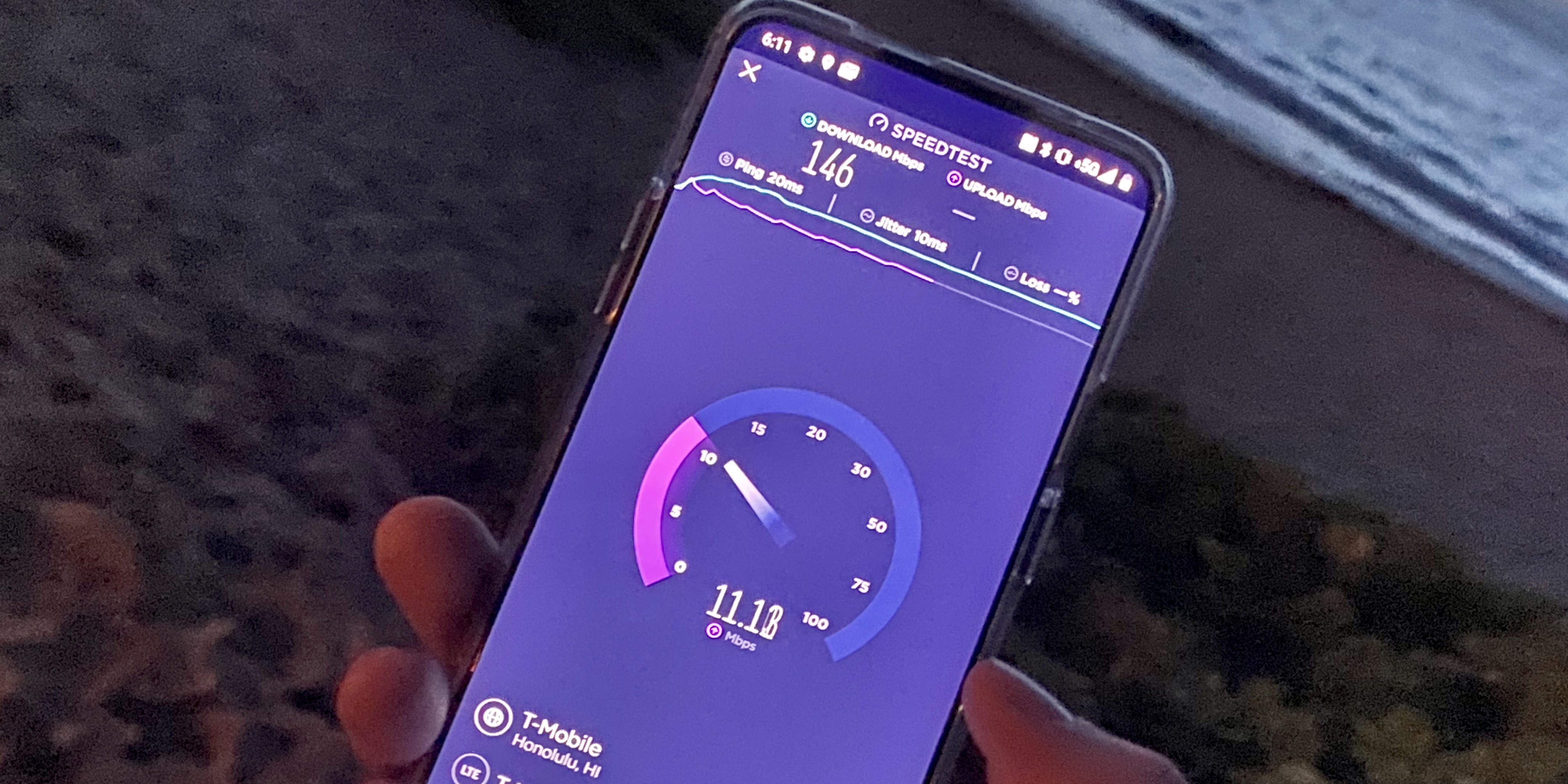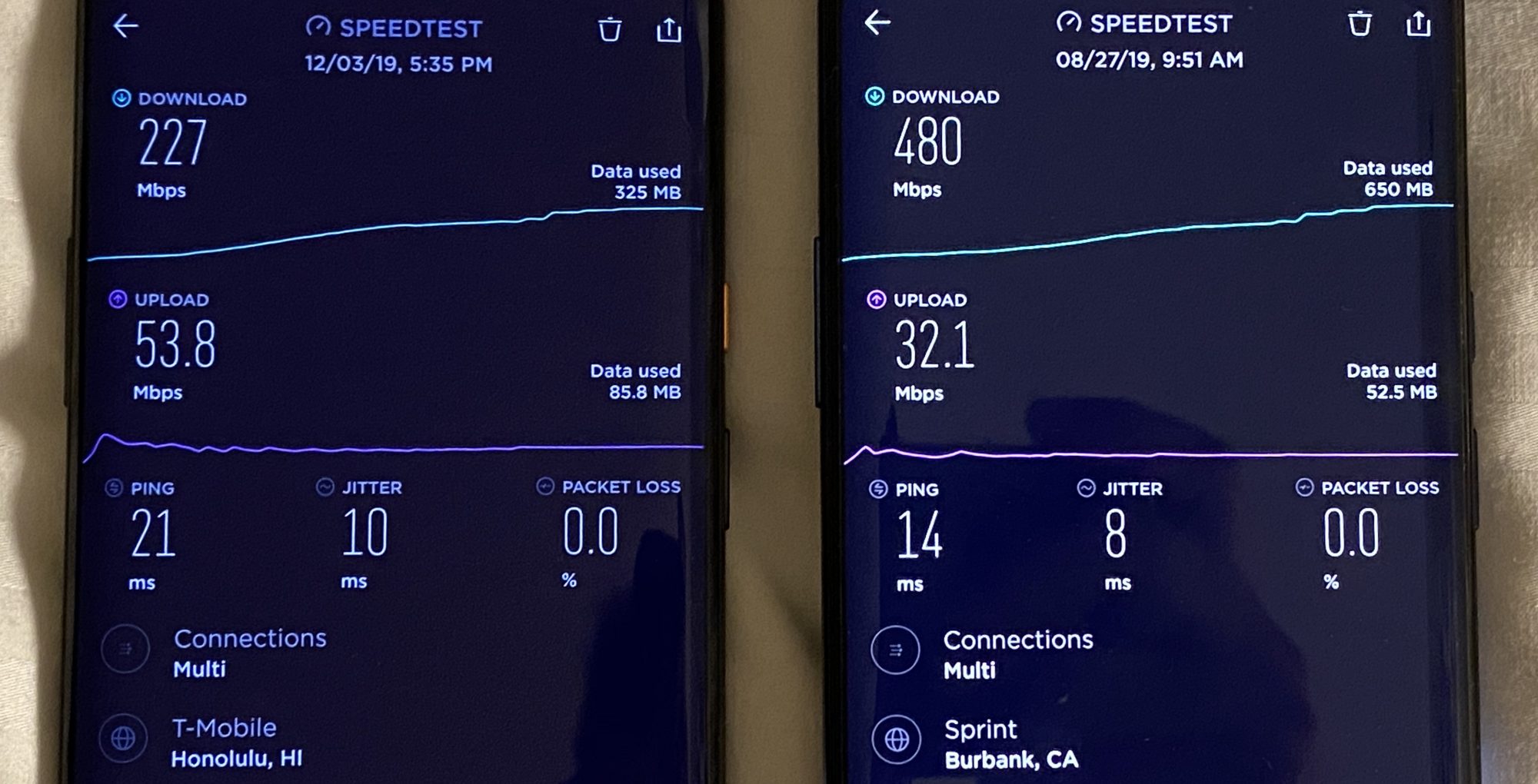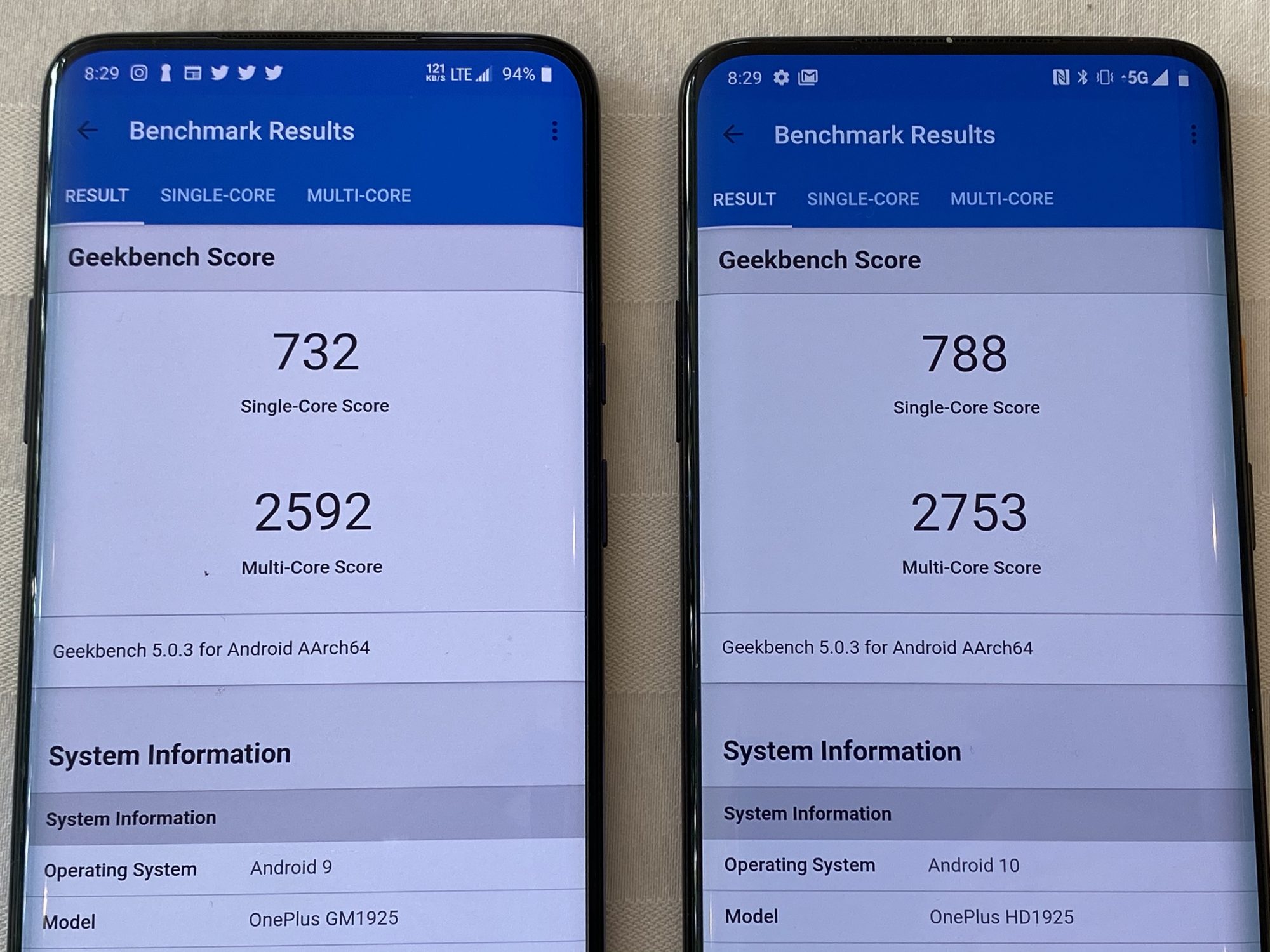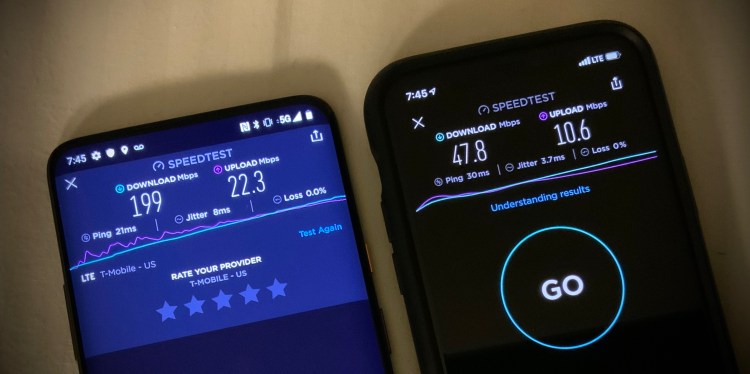I was actively worried — and somewhat confused — going into testing of T-Mobile’s first 600MHz “low-band 5G” handset, the OnePlus 7T Pro 5G McLaren. On the same day it flipped the switch on its nationwide 5G network, T-Mobile told customers to expect only a 20% improvement over LTE download speeds, an unimpressive promise made only after extensive discussions with its network engineering teams. While some areas will see 2 times LTE speeds, it says, the national average will be more modest, and the Un-carrier doesn’t want to over-promise performance.
To be blunt, that sounds awful. 5G was pitched as promising 10 times 4G/LTE performance, if not more, and in tests of Verizon’s and Sprint’s consumer 5G networks, I’ve personally seen peak speeds in the 500 megabits per second (Mbps) to 2 gigabits per second (Gbps) range, which is to say nearly 100 times faster than what many people experience on LTE today. Why even sell a new phone as “5G” if it’s only going to be a little faster than the prior-generation technology?
Thankfully, my initial testing of T-Mobile’s low-band 5G network revealed a more complex reality than the company’s conservative figure. The good news is that low-band 5G downloads peaked at 227Mbps, 2-4 times faster than T-Mobile’s LTE service at the same locations, and far higher than the aforementioned 20% estimate. But the bad news is that you won’t always achieve the peak speeds, and — surprise — early T-Mobile 5G phone adopters can’t actually use 5G for tethering, only smartphone service. More on that below.

Above: T-Mobile radio engineering SVP Mark McDiarmid discusses the company’s three-layer 5G strategy using a cake with Sprint’s mid-band in the center.
It’s important to put T-Mobile’s current 5G situation in proper perspective. The third place U.S. carrier has spent the better part of the past two years advancing a three-tier 5G strategy that was subsequently embraced by other carriers across the world, including its domestic rivals. 5G will begin with a blanket or base layer of slow but long-distance, low-frequency (600MHz) coverage; continue with faster, medium-distance mid-frequency (2.5GHz) towers; and end with super-fast but short-distance high-frequency (millimeter wave) small cells. T-Mobile is building the low- and high-frequency 5G parts itself, and will — assuming the merger goes through — integrate Sprint’s mid-frequency 5G network next year.
June 5th: The AI Audit in NYC
Join us next week in NYC to engage with top executive leaders, delving into strategies for auditing AI models to ensure fairness, optimal performance, and ethical compliance across diverse organizations. Secure your attendance for this exclusive invite-only event.
What we’re talking about here is solely the performance of that low-frequency 5G blanket, or what you’ll see in 5G performance when you’re not close to one of the shorter-distance, higher-frequency cell sites. To that end, T-Mobile loaned me a OnePlus 7T Pro 5G, the newer cousin to the OnePlus 7 Pro 5G I’ve been testing on Sprint’s network since August. Because I (and other early testers) are attending a Qualcomm Snapdragon Tech Summit in Maui, Hawaii and can’t escape the island until later this week, my results may differ from what you’ll see on the mainland.

Using Ookla’s Speedtest, my 5G download speeds ranged from atypically low 3-33Mbps results to a high of 227Mbps, though most of the numbers were in the 100Mbps range. I was able to pull down 100-150Mbps speeds while standing on a beach with no obviously apparent cell tower, speeds that on LTE generally required me to be within a tower’s line of sight. Upload speeds were typically in the 25-54Mbps range, similar if not identical to what I’ve seen from T-Mobile’s LTE network, with the odd occasional stall-out. That’s because T-Mobile says it’s currently using LTE for uploads, and expects to use 5G for uploads next year.
It’s worth briefly noting that my results were almost always better on the T-Mobile OnePlus 7T Pro 5G than on a new iPhone 11 Pro on LTE. That was also the case with the Sprint OnePlus 7 Pro 5G, but by a wider margin in Sprint’s favor — the difference being that T-Mobile’s 5G service is far more available across the U.S. than Sprint’s 5G, so you’re more likely to see it wherever you live.
While my highest tested speed on T-Mobile’s low-band 5G network was achieved on the terrace of a rooftop hotel restaurant, standing in just the right place, I also hit 130-199Mbps speeds in my hotel room without even walking over to the window or holding the phone in some awkward position. T-Mobile has touted the building-penetrating characteristics of its 600MHz network as a major advantage over competitors, as well as millimeter wave 5G, which can be snuffed out by some (not all) window coverings and walls.

Above: T-Mobile 5G on left, Sprint 5G on right.
So that’s the good news — T-Mobile’s big 5G blanket has a good chance of leaving you feeling warmer and fuzzier than you’ve felt with 4G. The bad news is the company’s 5G phone situation, which is a mess, and its tethering situation, which is also a mess.
Despite working on its three-tier 5G initiative for several years, T-Mobile relies on chipmakers such as Qualcomm and OEMs including OnePlus and Samsung to actually produce the modems and phones to support its 5G network. The OnePlus 7T Pro 5G I’m testing works on T-Mobile’s low-band 5G network, but not on its multi-city high-band 5G network. If the merger goes through, it will also offer 5G on Sprint’s mid-band 5G network. T-Mobile’s version of Samsung’s Galaxy Note10+ 5G apparently has the same characteristics, though the South Korean company does produce a Note10+ 5G variant with millimeter wave support.
If there’s any silver lining to this cloud, it’s that the merger offers hope that early T-Mobile 5G adopters will see even faster speeds in the coming year without having to buy new devices. As shown above, the Sprint OnePlus 7 Pro 5G delivers roughly twice the peak performance on mid-band, compared with T-Mobile’s peak speed on low-band. But without the merger, who knows. And bear in mind that the first phones with guaranteed support across millimeter wave, mid-band, and low-band 5G are expected to hit the market in early 2020.

Above: The OnePlus 7T Pro 5G McLaren is one of T-Mobile’s first two low-band 5G phones.
The status quo isn’t a good situation for consumers. And T-Mobile says that “due to initial 5G chipset limitations, all tethering traffic will be handled via LTE,” a capability it expects to make available next year via a software update. At this point, USB tethering appears to be completely disabled at the Android OS level. Oof.
For the time being, I personally wouldn’t buy any of T-Mobile’s early 5G phones. There are now two Samsung Galaxy options: the S10 5G, with only a handful of cities’ worth of millimeter wave support, and the Note10+ 5G, with low-band 5G but no millimeter wave. Alternately, there’s the far less expensive OnePlus 7T Pro 5G, which looks like a tribal-tattooed 7 Pro but packs a (barely) faster Snapdragon 855+ chip, faster screen refresh rate, and other small but welcome improvements. None supports T-Mobile’s entire 5G network.

Above: T-Mobile’s OnePlus 7T (right) variant looks and feels extremely similar to Sprint’s OnePlus 7, but packs a slightly faster processor, the Snapdragon 855+ rather then the 855.
As a daily T-Mobile user, I’ll be waiting on a phone that supports all three of the 5G tiers promised to customers. But for now I’m glad that even the lowest tier appears set to deliver performance superior to 4G.

